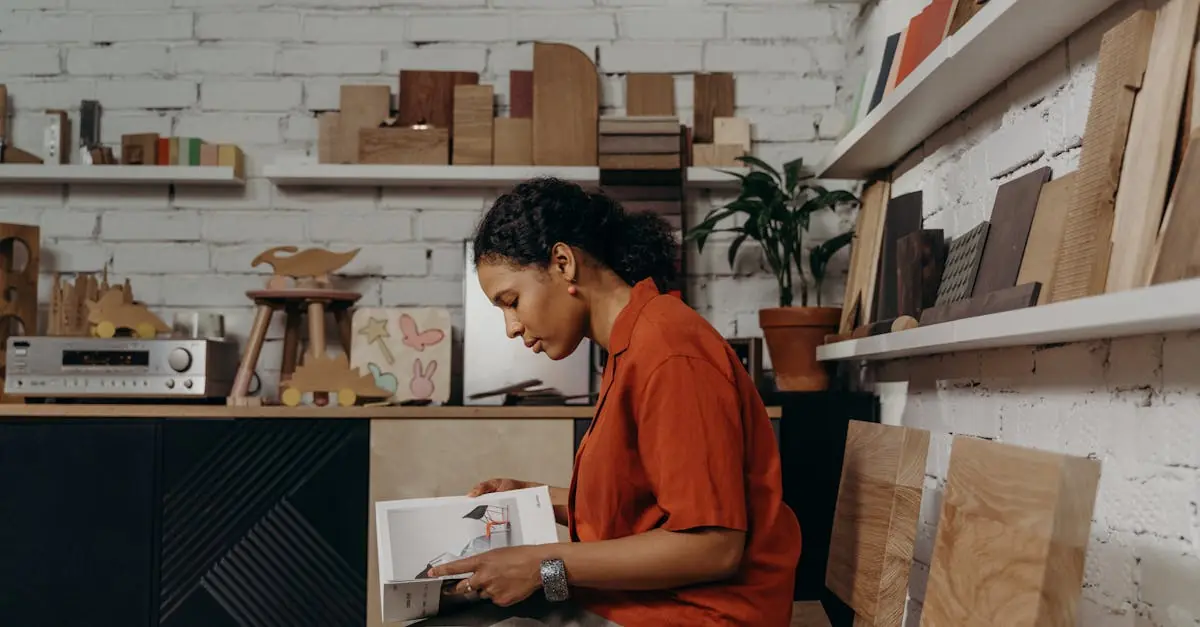In the ever-evolving world of home decor, furniture trends are like the latest dance moves—some catch on, while others quickly fade into oblivion. This year, it’s all about striking a balance between comfort and style, making your living space not just a place to exist but a sanctuary that reflects personality. Gone are the days of stiff sofas that feel more like a medieval torture device than a cozy spot to binge-watch your favorite show.
From bold colors that make a statement to sustainable materials that save the planet while looking chic, the furniture landscape is buzzing with fresh ideas. Whether you’re a minimalist at heart or a maximalist ready to embrace the chaos, there’s something for everyone. Dive into the latest trends that’ll have your friends questioning if you hired an interior designer—or if you just have a knack for style.
Table of Contents
ToggleOverview of Furniture Trends
The current furniture trends focus on creating inviting and comfortable spaces. A noticeable shift towards bold colors offers homeowners a chance to express their unique styles. Many opt for bright hues like teal, mustard, and burnt orange to breathe life into their interiors.
Sustainable materials become essential in furniture design, reflecting a growing awareness of environmental impacts. Designers incorporate reclaimed wood, bamboo, and recycled materials to meet both aesthetic and ecological standards. This trend resonates with consumers who value sustainability.
Mixed materials create visual interest in furniture pieces. Combining textures like metal and fabric or glass with wood enhances the overall appeal. The fusion of these materials leads to striking designs that break traditional norms.
Functional furniture remains a priority, catering to modern lifestyles. Multi-purpose pieces serve multiple roles, maximizing space efficiency. For example, sofa beds and extendable dining tables address the needs of smaller homes while maintaining style.
Another trend includes organic shapes over rigid lines. Curvy furniture adds a softer touch, promoting a sense of comfort and relaxation. Designers experiment with asymmetrical designs to create focal points in living spaces.
Lastly, personalization shapes furniture choices. Consumers increasingly seek pieces that reflect their individuality, leading to custom designs. This focus ensures furniture not only complements the home but also tells a story about its inhabitants.
Sustainable Furniture Trends
Sustainable furniture trends emphasize environmental responsibility while enhancing style and comfort. The industry shifts toward practices that minimize ecological impact and promote durability.
Eco-Friendly Materials
Eco-friendly materials play a crucial role in sustainable furniture. Options like reclaimed wood and bamboo reduce waste and conserve resources. Manufacturers utilize organic fabrics such as cotton and linen, which undergo less harmful processing than synthetic alternatives. Natural finishes, like water-based paints, minimize harmful emissions, making indoor air healthier. Many consumers prioritize these materials, valuing sustainability alongside design.
Upcycling and Repurposing
Upcycling and repurposing offer creative solutions for sustainable furniture. Individuals transform old pieces into new treasures, reducing landfill waste significantly. From turning pallets into coffee tables to revitalizing vintage chairs with fresh upholstery, creativity flourishes in these projects. This trend not only encourages environmental responsibility but also fosters uniqueness in home decor. Many artisans now specialize in crafting custom pieces that merge functionality with aesthetic appeal.
Minimalist Design Trends
Minimalist design trends focus on simplicity and functionality in furniture. These trends prioritize the essentials, stripping away unnecessary elements to create serene living spaces.
Functional Furniture
Furniture now emphasizes dual-purpose features. Pieces like ottomans with hidden storage and sleek desks that convert to dining tables cater to modern lifestyles. Versatile designs enhance utility while maintaining aesthetic appeal. Consumers increasingly seek furniture that serves multiple functions without compromising style. A clean, clutter-free environment aligns with minimalist ideals, promoting a sense of calm and order.
Open Space Concepts
Open spaces encourage fluidity and connection between rooms. Furniture arrangements often optimize flow, allowing for easy movement and interaction. Modular sofas facilitate adaptability, letting users change layouts as needed. Natural light plays a crucial role, with large windows and light-colored furniture enhancing brightness. These concepts aim to create an inviting atmosphere that fosters social interaction while maintaining a sense of tranquility.
Smart Furniture Trends
Smart furniture trends highlight the integration of technology and functionality in modern living spaces. Today’s consumers seek pieces that enhance comfort while incorporating innovative features.
Technology Integration
Smart furniture includes pieces equipped with technology that improves the user experience. For example, tables may feature wireless charging capabilities, while sofas might include built-in speakers and USB ports. These additions cater to the tech-savvy individual, blending modern conveniences with traditional furniture forms. Home offices also benefit, with desks offering integrated cable management systems and adjustable height mechanisms. Increased demand for smart home connectivity drives manufacturers to create furniture that syncs with various devices, making everyday tasks simpler and more efficient.
Multi-Functional Pieces
Multi-functional pieces serve the dual purpose of maximizing space and enhancing usability. Sofas that convert into bed frames allow for flexible guest accommodation, and coffee tables doubling as storage solutions aid in minimizing clutter. Furniture designed for compact living situations often comes equipped with hidden compartments for added functionality. Those prioritizing adaptability in evolving environments benefit from modular shelving units that can rearrange based on needs. By focusing on versatility, manufacturers create solutions that align with modern lifestyles, ensuring each piece serves multiple roles effectively.
Color and Texture Trends
Current trends in color and texture emphasize bold hues and natural finishes, reflecting a desire for personal expression and warmth in living spaces.
Bold Colors and Patterns
Bright colors like teal, mustard, and burnt orange dominate contemporary furniture design. These vibrant shades evoke energy and create focal points in rooms. Patterns also play a vital role, with geometric designs and abstract motifs adding visual intrigue. Layering different patterns fosters a dynamic feel, making spaces more inviting. Consumers increasingly choose bold colors to transform ordinary spaces into unique expressions of style. The playful mix of color and pattern allows individuals to curate personalized interiors that resonate with their tastes.
Natural Textures and Finishes
Natural textures enhance the visual and tactile experience of furniture. Materials like reclaimed wood and bamboo promote sustainability while introducing organic elements to interiors. These finishes contribute to a cozy atmosphere by softening the aesthetic of contemporary design. Fabrics such as linen and jute offer a warm feel and pair well with various color schemes. Incorporating woven materials adds depth and warmth to home decor. Embracing natural textures reflects a growing trend toward eco-friendly living while enriching the overall ambiance of spaces.
Embracing the latest furniture trends can transform any living space into a personal sanctuary. By prioritizing comfort and style through bold colors and sustainable materials, individuals can create inviting environments that reflect their unique tastes. The shift towards multifunctional and smart furniture caters to the demands of modern lifestyles, ensuring that every piece serves a purpose.
As homeowners explore these trends, they’ll find opportunities to express their individuality while promoting environmental responsibility. The fusion of aesthetics and functionality is key to achieving a harmonious balance in home decor. With creativity and intention, anyone can craft a stylish and sustainable living space that resonates with their lifestyle.



